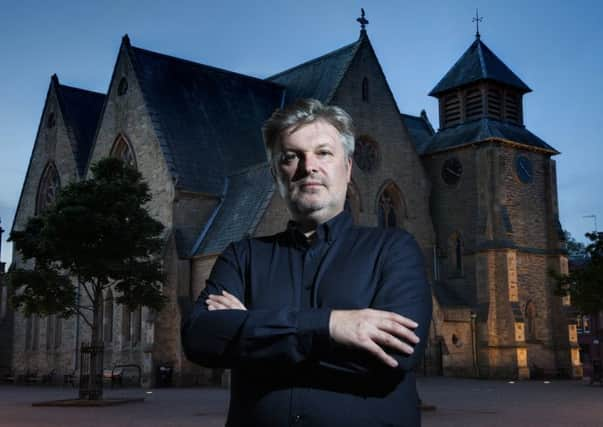James MacMillan’s Cumnock Tryst hires local heroes


It’s founder and artistic director is leading Scots composer James MacMillan, and as the title suggests, it’s happening in an Ayrshire town most people these days, by virtue of its convenient bypass, tend either to miss or avoid.
But it’s the town where MacMillan was born and brought up, where he and his wife Lynn attended the local Cumnock Academy, and a place he believes can be as attractive and successful a festival destination as the likes of Orkney, East Fife and East Lothian, whose St Magnus, East Neuk and Lammermuir festivals respectively are now established as unmissable crowd-pullers in Scotland’s cultural calendar.
Advertisement
Hide AdIf any of these provided the model and inspiration for Cumnock it was the St Magnus Festival, says MacMillan, which began in the 1970s revolving around the pulling power and inspiration of resident composer Sir Peter Maxwell Davies. MacMillan himself found early support and opportunity through Maxwell Davies, who championed his works in Orkney.
“I’d been thinking for many years, what if I could do in Cumnock what Maxwell Davies did in Orkney?” MacMillan says. “When Prince Charles put together the consortium to save Dumfries House, I thought that would be good for Cumnock and become a focus for regeneration in the area. There was suddenly a feeling of optimism and readiness for something like this to happen.”
He wanted to give something back to the town that shaped his yearnings to be a composer. “The local community was very musical when I grew up here,” he says. “I spent a lot of time singing in choirs, playing in brass bands. I remember a widespread love of music, with big crowds turning up for Cumnock Music Club concerts by great ensembles like the Berlin Philharmonic Octet and the Allegri Quartet.” That fell away as the town reeled from the demise of the local mining industry, he says. “But the embers are still there, and having been to so many little festivals around the world myself, I can see how small venues in towns like Cumnock can work extremely well.”
The MacMillans set about finding the money to fund the first festival, and the dream has now become a reality.The first Cumnock Tryst runs from 2-5 October, and there’s no doubt that MacMillan’s international celebrity has helped pull in top international performers.
The opening concert in St John’s Kirk features The Sixteen, Harry Christophers’ world-ranking vocal group for whom the composer has written some of his finest choral works. And the closing concert – a promenade event with a series of short performances in the 18th-century Adam-designed Dumfries House – spotlights the Festival’s patron, violinist Nicola Benedetti.
“I wanted to kick it off with a bang,” MacMillan says. “Something that would show how ambitious the festival is, and to have 300 people crammed into this little church to hear beautiful choral music from the deep past and the present will blow people away.” The Sixteen’s programme will include settings of the Stabat mater by composers from Estonia, Russia and England, as well as MacMillan’s own Miserere.
Advertisement
Hide AdBenedetti is just one of the major performers at the Dumfries House Finale, which will be performed twice on the closing Sunday, at 3pm and 7:30pm. Each performance is effectively three mini-recitals: the first a theorbo recital by Elizabeth Kenny in the mansion’s Tapestry Room; the second with Benedetti and members of The Sixteen in the Entrance Hall; and the third featuring the Scots ensemble Pure Brass in the Dining Room.
In each part there is a world premiere, new works by Benjamin Oliver, MacMillan and local boy Jay Capperauld, currently studying at the Royal Conservatoire of Scotland and rated highly enough by MacMillan to receive one of the first Cumnock Tryst commissions.
Advertisement
Hide AdOther Cumnock links have been tapped. Violinist Ian Peaston, who moved away from the town to pursue a classical career in Glasgow, Germany and Sweden, brings his extraordinary eclectic brand of solo electronic music to the Dumfries Arms Hotel. And before that, MacMillan is joined in the same venue by James Naughtie, poet Rab Wilson and Cumnock-born former Aberdeen goalkeeper Derek Stillie, for The Cumnock Hour, a panel discussion with an open agenda.
And the wider local community is involved too, with singers from local amateur choirs – which MacMillan sees as the seedbed for a future Festival Chorus – invited to join a Come and Sing Day led by members of The Sixteen on 4 October, with the evening given over to The Future of Brass, and performances featuring the National Youth Brass Band of Scotland alongside brass and string players from Greenmill Primary School and Cumnock Academy.
Completing the packed weekend programme is a presentation of one of the Scottish Chamber Orchestra’s Masterworks concerts on 4 October, in which master animateur Paul Rissmann will make sense of Swedish composer Karin Rehnqvist’s Arktis Arktis! prior to a full performance of the piece.
MacMillan is delighted with the reaction from people in Cumnock. “Tickets have been swallowed up, and there’s a real sense of excitement that local schoolchildren are involved,” he says.
And the future? “It’s a long-term thing,” says MacMillan, who sees his own role more as local composer-in-residence, working on school initiatives even outwith the festival period. “The 2015 festival is more or less in place, we’re talking about 2016 and 2017, and one commission is already in place for 2018.”
For MacMillan, there’s a feeling of homecoming as he prepares for the inaugural Cumnock Tryst. “Those I grew up with in Cumnock in the 1970s are now the head teachers in the area. It’s been like picking up threads of conversation that we left off 30 years ago.”
• The Cumnock Tryst runs from 2-5 October, www.thecumnocktryst.com